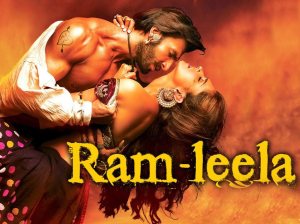Directed By: Sanjay Leela Bhansali
Written By: Sanjay Leela Bhansali
Cast:
Ranveer Singh – Ram
Deepika Padukone – Leela
Richa Chadda – Rasila
Supriya Pathak – Dhankor Baa
Gulshan Devaiah – Bhavani
Language: Hindi Genre: Romance; Drama
Ram-Leela set out to be the quintessential Indian romance but something stops it from making the mark. It had everything one expects from a Bhansali film – the grandeur of cinema, a visual cornucopia, a romance, beautiful music, great performances – but
And this three letter word ‘but’ peppers any reading of Ram-Leela. I’m going to borrow words from a director friend who described the film succinctly, ‘it is a beautiful film in a frame-by-frame shot – but – where (and this is my voice interrupting) is the logical continuity?
As I was watching I kept feeling that major portions of their romance got chopped up on the editing table because I couldn’t quite understand why they fell in love. The reason why Romeo and Juliet worked (on which this film is ostensibly based) is because of the innocence of the characters. They were too young and not yet jaded by life, so the idea that they loved each other was somehow believable. Ram and Leela are not that convincing.
At the outset it is established that the film is based on Shakespeare’s Romeo and Juliet and especially inspired by Baz Luhrmann’s adaptation (guns, modern settings yet culturally appropriate). What is really interesting to behold is that Bhansali has fused the storylines of popular sagas of star-crossed lovers into one narrative and oddly enough they flow well into each other. It is l suppose his tribute to every love saga written. Beginning with Heer-Ranjha, where the hero, a pampered younger son who is a lover of music and does not believe in fighting; to Romeo declaring his love in a garden of statues. It is also Layla-Majnun (Majnun means madman, referring to his madness when he loses her). There is even a nudge in the direction of West Side Story in the sexual assault on Rasila (Richa Chadda) when she takes a message from Leela (Deepika Padukone) to Ram (Ranveer Singh).
The film moves beyond the narrative of star-crossed lovers and I think tries to say something about India. The portrayal of women and the treatment meted out to them. How violence to women is a sport – the most telling incident being when Kesar (Barkha Bisht) is chased by Bhavani (Gulshan Devaiah) and his henchmen. It is set to music and is eerily reminiscent of Aishwarya Rai in the song sequence Man Mohini from Hum Dil De Chuke Sanam racing to place the last tile and being chased by the other players.
Unlike Bhansali’s other films, the male protagonist has received a much bigger opening. In fact, the image of Ram dominates the film – the painting on the wall in the streets of the Rajaris, of him in his warrior pose. Is it that the Indian male fails to fit into the mould he created (ideal, just, pure, and kingly)? That they are just parodies who worry more about prowess and are unable to take a stand? Conversely then do ineffectual boyfriends make chauvinistic husbands? It is ironic then that the male protagonist is called Ram.
Or maybe like the recurrent motif of the film – the peacock, it is about the male of the species being showier than the female.
There is much being displayed about male and female power relations within the narrative. Dhankor Baa (Supriya Pathak) the matriarchal head of the Sanera family where the men toe the line and the daughter has a freer rein. But the daughter –in law wishes for more time with her husband but his hands are still knotted to his mother’s skirt. Even within the relationship of Ram and Leela, he encourages her initiative before marriage but then becomes controlling after marriage. And she knuckles under.
It speaks about female desire and here the women take up stronger initiative to fulfil their desire but the men seem to hold back from a real fulfilment and prefer a wish fulfilment hence the preponderance of reference to porn. The film is Indian machismo on display for us. It can be considered a move towards a different Indian sexuality in the uninhibited display of love between Ram and Leela.
As a romance the film does not entirely work for me but if I read further into it, and maybe even do an orientalist reading, I might reach somewhere.

